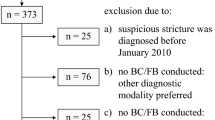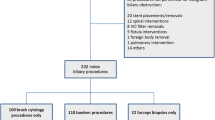Abstract
Background and Aims
Tissue specimen collection represents a cornerstone in diagnosis of proximal biliary tract malignancies offering great specificity, but only limited sensitivity. To improve the tumor detection rate, we developed a new method of forceps biopsy and compared it prospectively with endoscopic transpapillary brush cytology.
Patients and Methods
43 patients with proximal biliary stenoses, which were suspect for malignancy, undergoing endoscopic retrograde cholangiography were prospectively recruited and subjected to both biopsy [using a double-balloon enteroscopy (DBE) forceps under a guidance of a pusher and guiding catheter with guidewire] and transpapillary brush cytology. The cytological/histological findings were compared with the final clinical diagnosis.
Results
35 out of 43 patients had a malignant disease (33 cholangiocarcinomas, 1 hepatocellular carcinoma, 1 gallbladder carcinoma). The sensitivity of cytology and biopsy in these patients was 49 and 69%, respectively. The method with DBE forceps allowed a pinpoint biopsy of the biliary stenoses. Both methods had 100% specificity, and, when combined, 80% of malignant processes were detected. All patients with non-malignant conditions were correctly assigned by both methods. No clinically relevant complications were observed.
Conclusions
The combination of forceps biopsy and transpapillary brush cytology is safe and offers superior detection rates compared to both methods alone, and therefore represents a promising approach in evaluation of proximal biliary tract processes.



Similar content being viewed by others
Abbreviations
- CCC:
-
Cholangiocarcinoma
- DBE:
-
Double-balloon enteroscopy
- ERC:
-
Endoscopic retrograde cholangiography
- EUS-FNA:
-
Endoscopic ultrasonography-guided fine-needle aspiration
- HCC:
-
Hepatocellular carcinoma
- H&E:
-
Hematoxylin and eosin
- PAS:
-
Periodic Acid Schiff
- PSC:
-
Primary sclerosing cholangitis
References
Blechacz B, Gores GJ. Cholangiocarcinoma: advances in pathogenesis, diagnosis, and treatment. Hepatology. 2008;48:308–321.
Boberg KM, Jebsen P, Clausen OP, Foss A, Aabakken L, Schrumpf E. Diagnostic benefit of biliary brush cytology in cholangiocarcinoma in primary sclerosing cholangitis. J Hepatol. 2006;45:568–574.
Bergquist A, Glaumann H, Persson B, Broomé U. Risk factors and clinical presentation of hepatobiliary carcinoma in patients with primary sclerosing cholangitis: a case-control study. Hepatology. 1998;27:311–316.
Weber A, Schmid RM, Prinz C. Diagnostic approaches for cholangiocarcinoma. World J Gastroenterol. 2008;14:4131–4136.
Bennett JJ, Green RH. Malignant masquerade: dilemmas in diagnosing biliary obstruction. Surg Oncol Clin N Am. 2009;18:207–214.
Angulo P, Lindor KD. Primary sclerosing cholangitis. Hepatology. 1999;30:325–332.
Fleming KA, Boberg KM, Glaumann H, Bergquist A, Smith D, Clausen OPF. Biliary dysplasia as a marker of cholangiocarcinoma in primary sclerosing cholangitis. J Hepatol. 2001;34:360–365.
Boberg KM, Schrumpf E. Diagnosis and treatment of cholangiocarcinoma. Curr Gastroenterol Rep. 2004;6:52–59.
Harewood GC. Endoscopic tissue diagnosis of cholangiocarcinoma. Curr Opin Gastroenterol. 2008;24:627–630.
Selvaggi SM. Biliary brushing cytology. Cytopathology. 2004;15:74–79.
Gress TM. Molecular diagnosis of pancreaticobiliary malignancies in brush cytologies of biliary strictures. Gut. 2004;53:1727–1729.
Ponchon T, Gagnon P, Berger F, et al. Value of endobiliary brush cytology and biopsies for the diagnosis of malignant bile duct stenosis: results of a prospective study. Gastrointest Endosc. 1995;42:565–572.
Pugliese V, Conio M, Nicolo G, Saccomanno S, Gatteschi B. Endoscopic retrograde forceps biopsy and brush cytology of biliary strictures: a prospective study. Gastrointest Endosc. 1995;42:520–526.
Schoefl R, Haefner M, Wrba F, et al. Forceps biopsy and brush cytology during endoscopic retrograde cholangiopancreatography for the diagnosis of biliary stenosis. Scand J Gastroenterol. 1997;32:363–368.
Weber A, von Weyhern C, Fend F, et al. Endoscopic transpapillary brush cytology and forceps biopsy in patients with hilar cholangiocarcinoma. World J Gastroenterol. 2008;14:1097–1101.
Acknowledgments
We would like to thank all the participating patients for making this study possible. Our work was supported by German Research Foundation grants KU 1253/5-3 (H.K.) and STR 1095/2-1 (P.Str.). The technical assistance of Annemarie Schmid is greatly acknowledged.
Conflict of interest
The authors declare that they do not have anything to disclose regarding funding from industries or conflict of interest with respect to this manuscript.
Author information
Authors and Affiliations
Corresponding author
Rights and permissions
About this article
Cite this article
Kulaksiz, H., Strnad, P., Römpp, A. et al. A Novel Method of Forceps Biopsy Improves the Diagnosis of Proximal Biliary Malignancies. Dig Dis Sci 56, 596–601 (2011). https://doi.org/10.1007/s10620-010-1535-4
Received:
Accepted:
Published:
Issue Date:
DOI: https://doi.org/10.1007/s10620-010-1535-4




